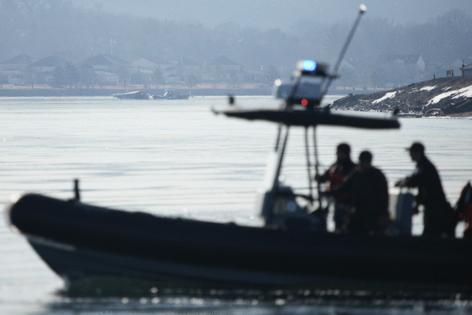Army helicopter was flying too high in collision with passenger jet over DCA: NTSB
Published in News & Features
WASHINGTON — The U.S. Army helicopter involved in the midair collision over Ronald Reagan National Airport in January was flying higher than it was supposed to be when it crashed into an American Airlines flight that was about to land at the airport, investigators found.
A hearing on Wednesday investigating the accident found that the helicopter exceeded the maximum altitude allowed along its route before the collision with the passenger jet. The altitude of the helicopter was the key subject on the first day of a three-day hearing.
A breakdown of flight data from the crash showed discrepancies between altimeter readings on board the Sikorsky-built Army UH-60L Black Hawk helicopter, which informed the height the aircraft was flying at when it collided with a PSA Airlines CRJ700 passenger jet above the Potomac River.
Data indicated that the Army pilot could have believed the helicopter’s altitude was lower than its actual height as it crossed paths with the jet. The helicopter collided with the airliner as the passenger jet was on its final approach to land at the airport, killing the helicopter’s crew and all passengers and crew aboard the jet — 67 people.
The Jan. 29 accident has been under investigation by the National Transportation Safety Board for the last six months. The board convened the hearing to obtain additional information from witnesses from the Army, the airline, Sikorsky, the FAA, and other parties.
Witnesses for the Army and Sikorsky described altimeter readings as a datapoint that pilots have to consider within a margin of error, particularly at low altitudes, due to inherent limitations with the technology that informs pilots of their height above the ground.
The Black Hawk helicopter involved in the collision used multiple methods to measure its altitude. One of those, a barometric altimeter, had an acceptable margin of error of 70 feet higher or lower than the indicated altitude.
A NTSB study that re-created the route of the Army aircraft involved in the crash found that the specific aircraft, the UH-60L Black Hawk, could have an altitude error of up to 130 feet when flying over the Potomac River.
The panel presented an animation that portrayed the progression of both aircraft before the collision. The Black Hawk’s flight path had a series of maximum altitude requirements, falling to 200 feet as the route approached the airspace around DCA. During its flight, the Black Hawk maintained an altitude that exceeded the maximum requirements.
As the aircraft came closer together, the animation showed that the helicopter increased its altitude to over 300 feet as the passenger jet descended to land.
“We have to understand that there are physical limitations to that,” Scott Rosengren, a witness for the Army, said about the altitude readings.
Rosengren and other Army witnesses expressed concern with the minimum separation required for aircraft to pass over each other in congested airspace.
The Federal Aviation Administration requires at least 500 feet between aircraft, but, in situations similar to the collision, the margin of error of an altimeter can result in aircraft passing by with less than 500 feet between, even if their altimeters indicate they are abiding by the required separation.
The hearing’s second panel examined the communications between the Black Hawk, the passenger jet, and the air traffic controller, as well as the routes the aircraft were flying.
Fifteen seconds before the collision, the air traffic controller told the helicopter pilot to pass behind the passenger jet. The NTSB found that the helicopter pilot didn’t hear the instruction because the mic key was being pressed.
The helicopter and the passenger jet were also unable to hear each other’s communications because they were on separate frequencies.
Though the routes of the commercial airline and the helicopter intersected, witnesses for the panel said that it was irregular for a military aircraft to try to pass underneath a passenger jet during its descent.
Standard practice for military pilots flying the route of the Black Hawk was to wait at a landmark earlier in the route if a commercial airline was inbound, as the PSA Airlines jet was. The pilots would only proceed once the commercial plane had passed.
The altitude on the helicopter’s route received the bulk of the attention, but the hearing also questioned the lateral drift of the Black Hawk. Though the route flown by the helicopter, known as Route 4, is shown on flight charts as a specific line for aircraft to follow, witnesses for the FAA said that the route doesn’t have bracketed markers of distance that pilots had to remain within. They described the charts as recommendations that can be adapted based on a pilot’s situation.
The Black Hawk collided with the passenger jet over the middle of the Potomac River.
Without specific lateral route requirements, the onus is on air traffic controllers to direct aircraft depending on the situation, multiple FAA witnesses said.
In March, the FAA permanently closed helicopter Route 4 between Hains Point and the Wilson Bridge following an NTSB recommendation. The closure followed reporting of a recurring pattern of near collisions between planes and helicopters in the vicinity of the route.
The NTSB released a report in March that found 85 instances between October 2021 and December 2024 of helicopters coming close to commercial jets near Reagan Airport.
The hearing will continue on Thursday.
_____
©2025 Baltimore Sun. Visit baltimoresun.com. Distributed by Tribune Content Agency, LLC.







Comments